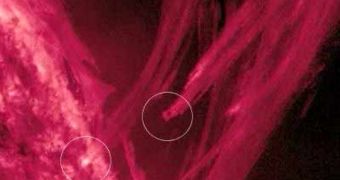Less than a week after experts at the American space agency released the first images snapped by the new Solar Dynamics Observatory (SDO), they return to the spotlight with a new video of the Sun. This time, the most recently-launched NASA telescope imaged a huge solar eruption, and kept an eye on the ensuing “rain,” which featured highly-magnetic plasma. The energetic event took place on April 19, Space reports.
“SDO has just observed a massive eruption on the Sun – one of the biggest in years. The footage is not only dramatic, but also could solve a longstanding mystery of solar physics,” says Dr Lika Guhathakurta, who is the lead program scientist for the “Living With a Star” (LWS) initiative. She is also the program scientist for the Solar TErrestrial RElations Observatory (STEREO) mission, at the NASA Headquarters Science Mission Directorate, in Washington, DC. The official reveals that such strong eruptions are not unheard of, but adds that scientists haven't seen one of them in a long time.
And, unlike other instances of such explosions, investigators keeping an eye on this phenomenon can now benefit from the incredible resolution and observations power of the SDO, which was especially designed for this task. “It's huge. We can see a billion tons of magnetized plasma blasting into space while debris from the explosion falls back onto the sun surface. These may be our best data yet,” says of the solar blast Lockheed Martin Solar and Astrophysics Lab scientist Karel Schrijver. The SDO movie spans about four hours of real time, and shows how our entire planet could easily fit in the magnetic plasma rain.
“Blobs of plasma are falling back to the surface of the sun, making bright splashes where they hit. This is a phenomenon I've been studying for years,” the expert says of the coronal rain. He adds that the greatest mystery associated with this phenomenon is not why it happens, but rather how. While experts know that the Sun's gravity is strong enough to make at least some of the plasma fall back, they can't yet explain why the matter appears to be falling so slowly back towards the stellar surface. Using new data from the SDO, the mystery is beginning to get some clarifications.
“The Sun's gravity should be pulling the material down much faster than it actually moves. What's slowing the descent? The rain appears to be buoyed by a 'cushion' of hot gas. Previous observatories couldn't see it, but it is there,” Schrijver reveals. “You can see the hot gas in the color-coded temperature movie. Cool material is red, hotter material is blue-green. The hot gas effectively slows the descent of the coronal rain,” he adds.

 14 DAY TRIAL //
14 DAY TRIAL //